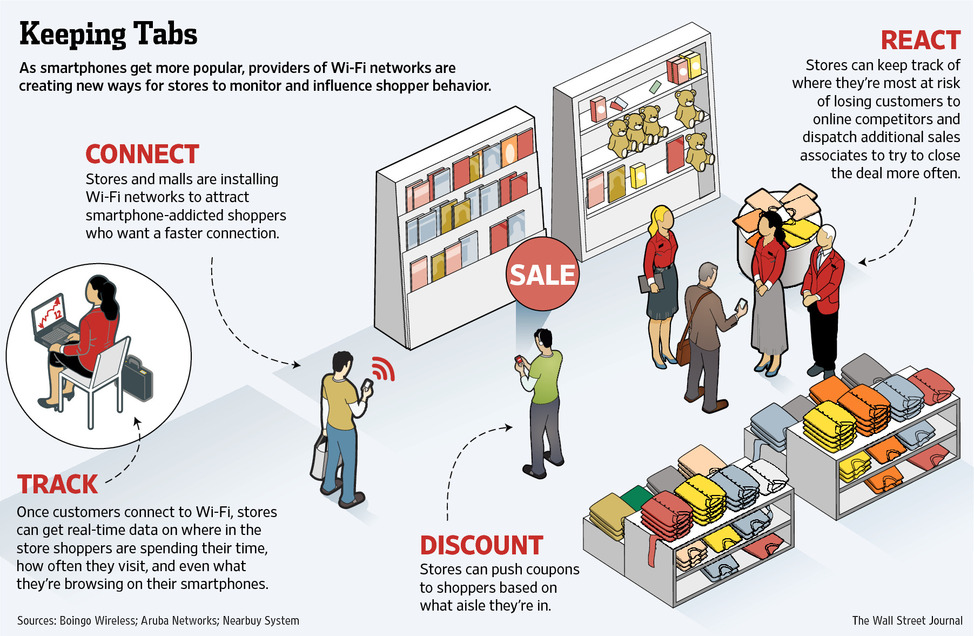A trend in retail over the past few years has been to offer free wifi to customers while in the store. There are several elements here: benefit to the customer, benefit to the brand and potential benefits to competitors. I recently saw a humorous internet post of a store with a sign on the door alerting customers of a $5 fee for entering the store and not purchasing anything.  Even if this wasn’t meant as a joke, it does raise a very real question of how retailers and others approach the balance of providing increased access to the Internet in their stores or if they shut it out completely. Surprisingly, some retailers have been focusing on the opposite end of the spectrum in developing ways to block signals to personal devices while in the store.
Even if this wasn’t meant as a joke, it does raise a very real question of how retailers and others approach the balance of providing increased access to the Internet in their stores or if they shut it out completely. Surprisingly, some retailers have been focusing on the opposite end of the spectrum in developing ways to block signals to personal devices while in the store.
Retail store providing wifi claim it is a value-add service to allow their customers to use the Internet without charge. Of course, there is almost always a registration process, and some requires you to submit your name and email to the Internet service provider. If you actually read the service terms on most of these agreements (which, of course, no one actually does), some of them say that your privacy is not guaranteed and your personal information could be shared with others for marketing purposes. Just think, all you really wanted was some free wifi and now your signed up to email spam central. Is that a good shopping experience?
But the tracking capabilities of free wifi dont end there. In theory, the controller of a wifi access point can track all the data passing through their system - browsing behavior, personal info, purchases, etc. Therefore, “free Internet” is a relative term and concept, as a customer’s activity and identity definitively hold worth.
But its not just identity and online browsing behavior that can be tracked. Using the transmitter of the wifi signal, these systems have the ability to ping customer’s personal devices in the store, both registered and unregistered for free wifi, and determine their movement patterns through the store. Are customers lingering in front of the sunglasses section? Are they completely missing that new end-cap display in mensware? Through services like Euclid analytics, although most customers don’t opt in to send location data, the existence of a device and wifi signal allows the store to know where customers travel throughout the store. Some stores will post that this is occurring and give customers the ability to opt out but many others do not. Don’t want to be tracked at all? Some stores advise you to turn off your phone to be completely sure. Who wants to do that?

An excellent illustration from the Wall Street Journal on why wifi tracking is so interesting to retailers.
Shopkick, a popular shopping app that employs gamification via points earned from activities users do in-store, tracks users in a similar fashion. It uses inaudible audio frequencies emitted from small boxes in a store that can be heard by the microphones on personal devices to locate and track a device in store. But all users of Shopkick are opting in to participate in the shopping app.
There are some ethical challenges to calling something “free wifi” when there is significant data being generated both via emails and location data which hold value. Maybe it should be called “wifi sponsored by your data.” Like cookie tracking on the Internet, we can imagine that this 3rd party data tracking might fall under similar scrutiny as consumers understand how this free wifi ecosystem is working.
Privacy and data aside, it’s a good move for these retailers to continue making the investment in wifi in-store - because the future of the in-store experience is in a connected experience. As advancements in various iterations of RFID continue to advance and the interactions between the digital world and the physical world become more seemless, we expect to see the real-time optimization mantra of online fuse with offline. In order to power many of these advancements and interactions, smartphones and wifi are a necessary part of that foundation.
That said, free wifi without a creative and engaging customer experience offered as part of it is a massive missed opportunity and an open invitation for customers to “showroom” a store and find better pricing elsewhere. Rather than block in store wifi and thus, try to prevent showrooming, how about using in-store connectivity as a way to renew customers’ interest in the brand through a creative experience? Existing retailer shopping apps dont do this very well. From the utilization numbers we’ve seen for these apps, customers dont want to scan bar codes and see a smaller version of the brand website in a store, they want a more engaging experience. There is immense untapped potential in the realm of in-store personalization.
The concept of free wifi in store is more complex than it initially appears. Brands need to not only focus on anonymous tracking data but how they can maximize a rich and creative value exchange with customers in the store. The opportunity is there today. Customers are waiting for something beyond scanning barcodes a little faster with free wifi. We’re excited to see who takes the leads and innovates.